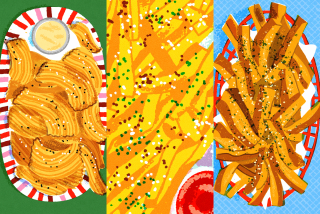Fish and Chips Still on Menu in Britain
- Share via
GUISELEY, England — The dining room featuring a chandelier is full, and a hungry crowd waits outside for a table at the most famous restaurant in town.
On the menu: fish and chips.
In a fast-food age of American-style hamburgers and Italian pizzas, some Britons still savor the old culinary art of crispy fish and chips (french-fried potatoes).
And Harry Ramsden’s, a celebrated fish and chip restaurant in the northern town of Guiseley, is where the old-fashioned gourmets come for a finer taste of British heritage.
Harry Ramsden’s boasts a long history that has turned the humble dinner into big business.
The company, founded as a tiny food kiosk in this Yorkshire town 64 years ago, is Britain’s only fish-and-chip fryer to have a chandelier decor and shares traded on the stock market.
But its fare is strictly traditional, an echo of the days when the ubiquitous curry restaurant had yet to arrive on the nation’s high streets.
Judging by the lines, Britain still has a taste for fish and chips flavored with salt and vinegar , its fast-food staple and most famous contribution to world cuisine along with warm beer and roast beef.
Britons consume 600,000 tons of chips and 56,000 tons of white fish every year, bought from more than 9,000 local fish-and-chip shops, according to figures from the National Federation of Fish Fryers.
The north eats more of the national dish than the south--but then the industrial heartland of Yorkshire and Lancashire, with its local fishing fleet and factory workers to feed, has always been a bastion of the fish-and-chip supper.
A new study by social historian John Walton of Lancaster University concludes that a plentiful supply of fish and chips at affordable prices helped quell social unrest among the “lower orders” and kept up morale during two World Wars.
In his analysis “Fish and Chips and the British Working Class,” Walton declares that the thousands of “chippies”--small fish fryers serving poorer communities--helped explain why class-divided Britain was barely touched by the revolutionary fervor that has convulsed other European countries.
Harry Ramsden, the founder of the fish-and-chip empire, set up shop in Guiseley with two pans and a tiny hut in 1928. He put his shop near a streetcar terminus for day-trippers to the Yorkshire countryside and the Lake District and within a few years the wooden hut had been replaced by a posh restaurant.
The company went public in 1989, issuing shares to fund an expansion program that aimed to take the fish-and-chip dinner around the world.
Some longstanding Harry Ramsden’s customers, however, mutter darkly about soggy batter and falling standards.
Harry Ramsden’s makes few concessions to changing tastes.
Battered cod, haddock or plaice in varying sizes comes with white bread and butter and a dish of simmered “mushy peas” for around $9 a person.
The all-important batter is made from a secret recipe with Canadian flour. The secret of the crispy chip lies in the frying temperature, ideally 365 degrees Fahrenheit, and the fat--beef drippings.
Restaurant manager Rupert Edmonds, who admits to being no fan of mushy peas, says foreign customers are intrigued by this bright green delicacy made by cooking dried peas with bicarbonate of soda. “They put it down to eccentric British tastes,” he said.
More to Read
Eat your way across L.A.
Get our weekly Tasting Notes newsletter for reviews, news and more.
You may occasionally receive promotional content from the Los Angeles Times.










